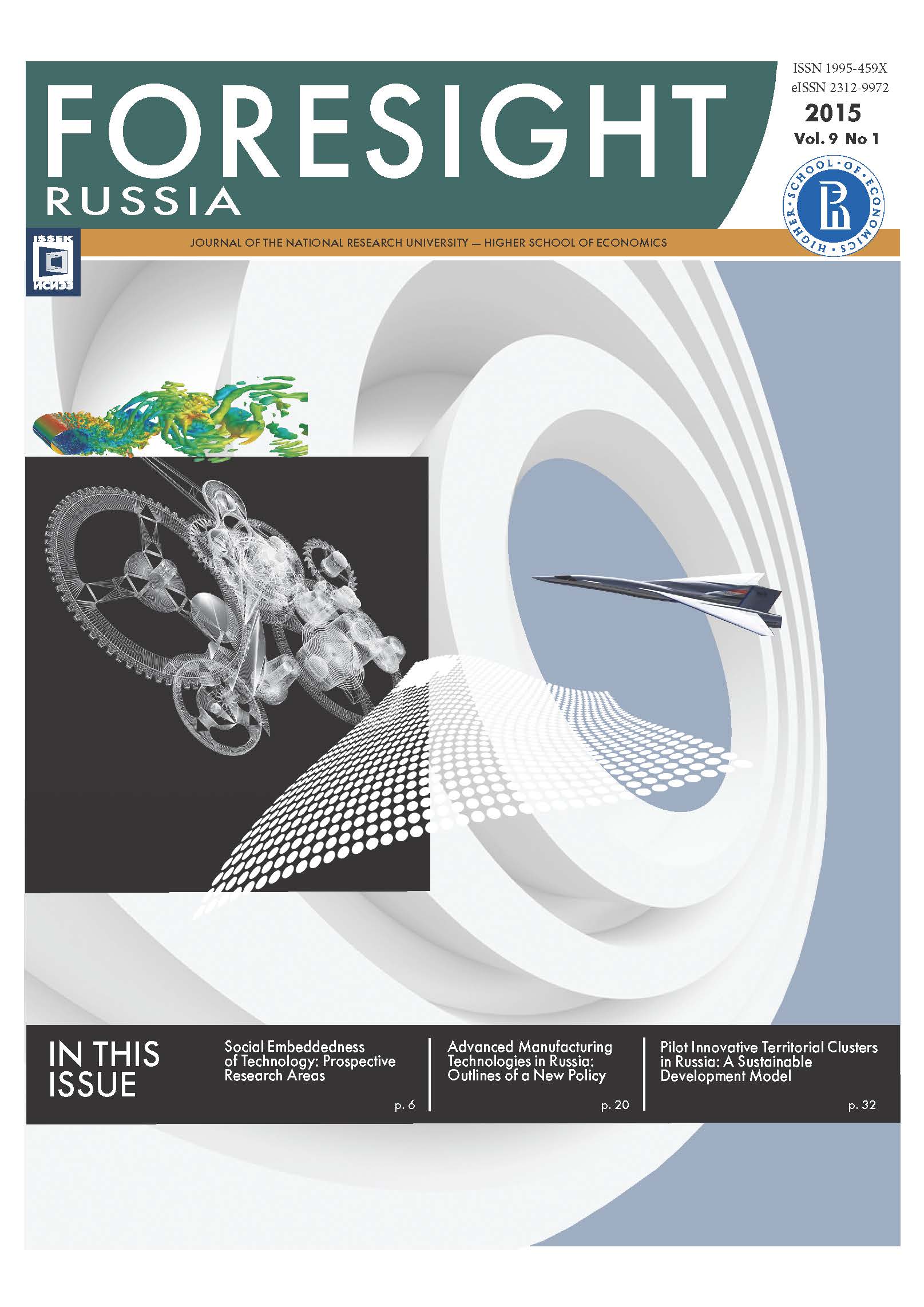Abstract
The need to address the tremendous technological and investment risks intrinsic to the stages of business structuring and drawing up a business model means that an optimal tool to support innovative start-ups is sought. Continuity of the innovation process depends on the efficiency of individual instruments of implementing innovation and indeed on the entire infrastructure. Foreign experiences have shown that an acceleration mechanism to support innovative projects with the appropriate involvement of all stakeholders can be effective. This approach is embodied in regional business catalysts, combining organizational, managerial, research and production, and technological competences of the various actors of the innovation process, thus reducing the 'seedbed' costs and improving the quality of projects at the riskiest stages of the innovation process.
The article reveals the importance and place of regional business catalysts in the innovation infrastructure toolbox, in particular the role they play in helping newcomers overcome the so-called 'valley of death' and in aiding innovative companies find investment. Regional business catalysts do this by synchronizing and coordinating competences of regional participants of the innovation process on the basis of common standards and a transparent selection procedure. Business catalysts can also contribute to an overall revitalization of innovative activity in regions.
Examples of regional business catalysts introduced in Russia suggest that the region’s high scientific and educational potential, the development of innovation infrastructure, and support of the authorities are key to catalysts’ effectiveness. A performance assessment of the first national business catalyst, launched in the region of Rostov in 2012, confirms the effectiveness of catalysts in establishing horizontal linkages between the regional business community and institutions supporting innovation at the local and federal level.
The authors describe the objective difficulties faced by regional business catalysts that are driven by the specificities of the engineering and manufacturing expertise for some projects and the complexity in establishing cooperation with key institutions of regional innovation infrastructure. Future developments are suggested to consolidate business catalysts’ sectoral affiliation, to develop the networking aspects, ensure transparency of this mechanism, as well as expand partnerships between regional industry, academia, and government institutions to support innovative entrepreneurship.
References
Abetti P.A. (2004) Government-Supported Incubators in the Helsinki Region, Finland: Infrastructure, Results, and Best Practices//Journal of Technology Transfer. Vol. 29. P. 19-40.
Butcher M. (2011) Seedcamp named top European accelerator, with Startupbootcamp closing in//TechCrunch. 20.06.2011. Режим доступа: http://techcrunch.com/2011/06/20/seedcamp-named-top-european-accelerator-withstartupbootcamp-closing-in/, дата обращения 14.02.2015.
Etzkowitz H. (2003) Innovation in Innovation: The Triple Helix of University-Industry-Government Relations//Social Science Information. Vol. 42. № 3. Р. 293-338.
Etzkowitz H., Pique J. (2005) Silicon Valley in Transition from Network to Gravitation Field. Paper presented at the International Association Science Parks Conference, Helsinki, 2005.
Hoffman D., Radojevich-Kelley N. (2012) Analysis of Accelerator Companies: An Exploratory Case Study of Their Programs, Processes, and Early Results//Small Business Institute. Vol. 8. № 2. Р. 54-70.
Lewis D.A., Harper-Anderson E., Molnar L.A. (2011) Incubating Success. Incubation Best Practices That Lead to Successful New Ventures. Ann Arbor, MI: University of Michigan. Режим доступа: http://www.nist.gov/ineap/upload/Incubating-Success-Report.pdf, дата обращения 20.04.2014.
Malek K., Maine E., McCarthy I. (2012) A benchmark analysis of Canadian clean technology commercialization accelerators//IEEE PICMET Proceedings. P. 863-845.
Malek K., Maine E., McCarthy I. (2014) A typology of clean technology commercialization accelerators//Journal of Engineering and Technology Management. Vol. 32. P. 26-39.
Miller P., Bound K. (2011) The Startup Factories: The rise of accelerator programmes to support new technology ventures. London: NESTA.
Nelson R.R., Winter S.G. (1982) An Evolutionary Theory of Economic Change. London; Cambridge, MA: Cambridge University Press.
O'Connell B. (2011) Start X: Training ground for Stanford's best and brightest. Kansas City, MO: Kauffman Foundation. Режим доступа: http://www.entrepreneurship.org/en/eMed/eMed-Blog/2011/October/StartX-Training-groupnd-for-Stanfords-best-and-brightest.aspx, дата обращения 10.06.2012.
RVC (2014) Карта акселераторов. Инфографика//Russian Venture Chronicle. № 1. C. 24-25.
World Bank, infoDev Finance (2012) Early Stage Innovation Financing (ESIF) Facility. Washington, D.C.: World Bank, infoDev Finance.
Yin R.K. (2003) Case Study Research Design and Methods. Thousand Oaks, CA: Sage.
Аккерман К. (2014) QIWI взялась за стартапы. В Москве прошла презентация бизнес-акселератора QIWI Universe//Bankir.Ru. 28.07.2014. Режим доступа: http://bankir.ru/novosti/s/qiwi-vzyalas-za-startapy-10082383/,дата обращения 09.12.2014.
Аммосов Ю.П. (2005) Венчурный капитализм: от истоков до современности. СПб.: Феникс.
Голиченко О.Г. (2006) Национальная инновационная система России: состояние и пути развития. М.: Наука.
Гохберг Л.М. (2003) Национальная инновационная система России в условиях «новой экономики»//Вопросы экономики. № 3. С. 26-44.
Гохберг Л.М., Кузнецова И.А. (2009) Инновации в российской экономике: стагнация в преддверии кризиса?//Форсайт. Т. 3. № 2. С. 28-46.
Гохберг Л.М., Кузнецова Т.Е., Агамирзян И.Р., Белоусов Д.Р., Китова Г.А., Кузнецов Е.Б., Рудник П.Б., Рудь В.А., Сагиева Г.С., Симачев Ю.В. (2013) От стимулирования ин-новаций к росту на их основе//Стратегия -2020: Новая модель роста (книга 1)/Под науч. ред. В.А. Мау, Я.И. Кузьминова. М.: Изд. дом «Дело». С. 92-127.
НИУ ВШЭ (2011) Российский инновационный индекс/Под ред. Л.М. Гохберга. М.: НИУ ВШЭ.
Тимохина Е. (2014) Обитаемый Lift, или инкубатор на рыночных условиях//Деловая среда. 06.02.2014. Режим доступа: http://journal.dasreda.ru/practice/4852-obitaemyy-lift-ili-inkubator-na-rynochnyh-usloviyah, дата обращения 09.12.2014.

This work is licensed under a Creative Commons Attribution 4.0 International License.

